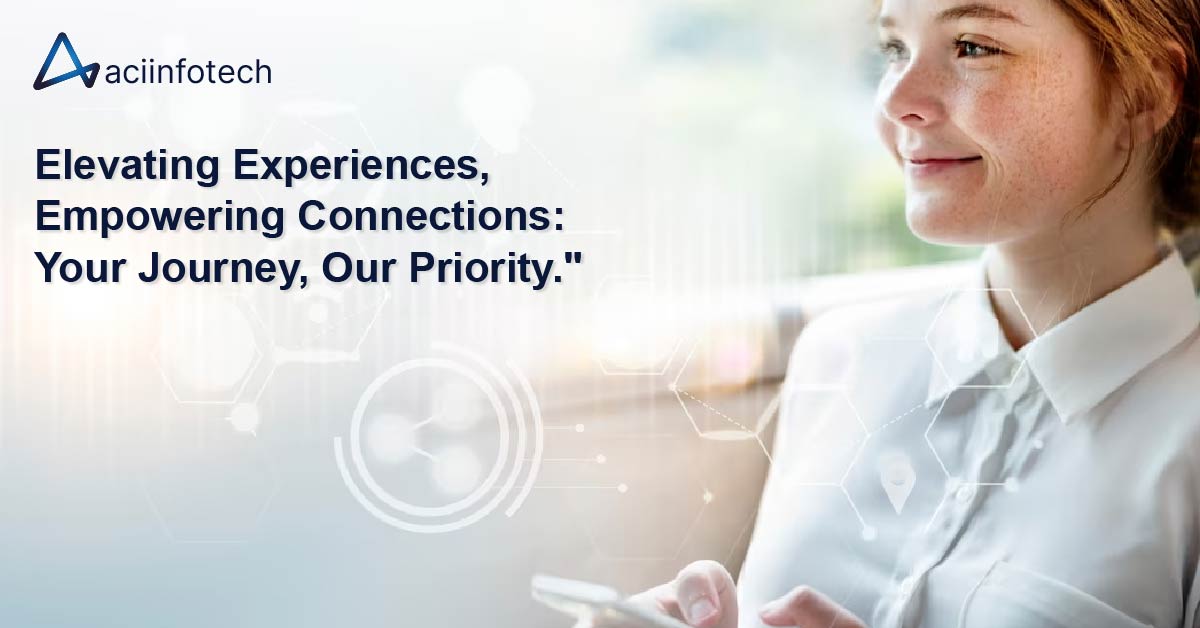The digital era is transforming the way we do business and deliver services. To thrive in this new environment, organizations must embrace technology to transform their processes and deliver end-to-end customer experiences. The customer edge is where all of this takes place; it's where interactions occur between a customer and a company at scale. They are more critical — and more complex — than ever before.
Today, many businesses have no way to drive the customer experiences necessary to remain competitive. This should be a concern to every business that intends to stay relevant in the market, because 86% of business leaders expect their competition to be majorly based on customer experience. Many businesses are moving from ad hoc to strategic provisioning of edge computing services. Digital experiences are increasingly being designed for local delivery. Edge computing helps businesses optimize the customer experience by accelerating data access. Here are some insights on how to up your customer experience game and stand the test of time.
The customer edge: Where the experience happens
The customer edge is where the experience happens. It's where you have conversations with customers and manage their interactions with your products, services, and brand. The customer edge is where your customers are interacting with your products—or more accurately, they're interacting with the digital experiences created by you on behalf of them. 81% of a survey by Full Story said that they are more likely to increase their online activities even when in person activities resume. This is exactly why the digital experience should be at par.
The key to creating a great digital experience at this point lies in understanding how to best respond to what's happening here:
- What do they want?
- How can we help them get there?
- Why the customer edge is key to a successful digital experience.
The customer edge is key to a successful digital experience. It’s where the experience happens, and it's also where the action is. Why? Because your customers are there!
The customer edge isn't just a new battleground for your company—it's also where you can best deliver on your promise of delivering an exceptional customer experience (CX). And if you want to understand what makes for a great CX, then consider this: 85% of all customer interactions happen at the end-user level—in other words, in front of your face! This means that if you want to deliver on your brand promise through digital channels like CRM or eCommerce, then DEO is essential as well because it unifies all aspects of service performance holistically across traditional silos within IT systems using virtualization technologies such as VMware vSphere 6th Edition Plus or Microsoft Hyper-V Containers.
Customer edge services are more critical — and more complex — than ever before. Edge computing is the next frontier for digital business. It involves using data-rich servers and devices at the edge of networks to provide real-time computing, applications, and services. It can also improve the customer experience by delivering better performance, lower latency, and more advanced analytics cost-effectively. For example, airlines use edge infrastructure to reduce flight delays by managing their entire fleet of aircraft remotely from one location—and they’re able to do this while recovering costs associated with legacy systems that were not designed for such distributed operations management (DORM).
While there are many benefits to using edge technologies like machine learning (ML) or artificial intelligence (AI), there are some challenges along with them:
-
Scalability: The more complex your application becomes, the harder it becomes to monitor its performance across different types of devices;
-
Security: Because these systems operate outside traditional IT boundaries, you need better security measures than those used inside corporate environments;
-
Cost: You may need additional hardware resources beyond what was needed when deploying traditional desktop PCs onto an internal network – especially if those machines will be used as part of an internet-facing service such as email delivery or social media posting platforms
The way your business will use these technologies depends on what role they play in delivering value. Customer Edge Services could be used by any organization involved with customer interaction (i.e., within your internal team). These tools include chatbots, virtual assistants, and voice search engines that help in different ways depending on who they're serving—for example:
-
Chatbot - Automate repetitive tasks so employees don't needlessly spend time handling routine inquiries from clients or customers
-
Virtual Assistant - Help customers navigate complex questions related to their products/services
-
Voice Search Engine - Simplify searches by providing relevant results based on keywords entered into conversational interfaces
Digital experiences are increasingly being designed for local delivery. But what does this mean exactly?
Local delivery is the practice of delivering digital content and services to customers in their area, rather than sending them an email or having them go through another step in the process. For example, instead of sending someone an email asking them to fill out a form on your website, you could send them a link directly from your site so they can complete the task themselves (or even better—they can complete it online). This allows you to tailor your message based on where your customers are located and what they need at that time: if someone is commuting between two cities each day then one city might be hot right now while another has never been visited before; these factors affect how people choose which information/interaction will work best for them when they arrive at their destination! This, for instance, is the perfect opportunity to leverage edge computing!
What is Edge Computing?
Edge computing is a term used to describe a computer or cluster of computers that are located near the customer, such as in their home or office, rather than at a centralized server farm. This means that instead of relying on servers located far away from where you need them (such as in data centers), you can use local connectivity to access your data faster than ever before. Edge computing helps businesses optimize the customer experience by accelerating data access. This is a good thing, as it shows that businesses are starting to realize the benefits of edge computing and how important it is for their business growth. The technology is not just for large companies or start-ups; it has wide applications across industries, including retail and manufacturing.
How your business can take advantage of edge computing to improve the customer experience.
The goal of edge computing is to provide a better customer experience by using the cloud, but with fewer resources. As such, it can improve efficiency and agility in your business by reducing costs while still delivering the same or better performance.
Edge computing also helps businesses improve their security posture by allowing them to move sensitive data from their data centers onto secure servers located on the edge of the network—or even off site entirely. This gives you an extra layer of defense against hackers who might try to steal information from these systems if they were located within your network perimeter (i.e., within your firewall). For businesses, managing customer experiences at the edge of your network is increasingly important as more business technology moves to the cloud. Edge computing is a way to manage these experiences by creating a centralized customer-experience cloud that includes both data and software. In addition, it can help businesses deliver digital experiences where customers are—whether they’re using mobile devices or accessing desktop applications in an office setting.
It also allows you to implement more efficient ways of building and deploying applications across multiple locations and devices—which means faster time-to-market for new products or services; better security than traditional data centers; lower cost of ownership due to lower hardware requirements; and greater flexibility in meeting changing needs across different types of users (e.g., employees versus consumers).
How to ensure your customers have a consistently good digital experience
There are many ways to ensure that your customers have a consistently good digital experience. The following steps can help you get started:
- Develop a strategy for digital transformation. It’s important to understand what your customers need and expect from their interactions with your business so you can create a customer experience strategy that meets those needs and expectations.
- Design a customer experience strategy based on market research, data analysis, and insights from employees across the organization who talk directly with customers or work in person with them (such as sales representatives). This will help guide the overall direction of both internal and external communication efforts as well as internal policies around how things should be done—for example, how often someone must update their profile information on Facebook or LinkedIn. Or whether there should be limits on how much personal information people can post online before they're warned about privacy concerns by an alert message popping up on the screen telling them not to do so anymore!
- Create an implementation plan consisting of goals such as analyzing current processes around acquiring leads through social media channels vs traditional methods such as cold calling potential clients first; determining whether this new approach works well enough until further notice before proceeding further along this path toward improving effectiveness overall--this step involves measuring results after implementing some changes so we know whether they've worked out OK overall."
- You can deliver end-to-end customer experiences using Dynamic Edge Orchestration (DEO), a platform that manages the customer and employee services at the edge of the network. DEO is a platform that manages the customer and employee services at the edge of the network. It provides a single platform for delivering end-to-end customer experiences, whether it's through video or text messaging. A key part of any digital transformation strategy, DEO helps enterprises reduce downtime and improve collaboration between all members of their workforce—from sales representatives to IT professionals to call center agents—by providing seamless access to critical business applications across multiple devices in real-time. This improves efficiency while reducing costs by eliminating unnecessary trips back and forth across corporate boundaries.
Conclusion
The customer experience is a key element of the digital transformation process. It is not only the result but also the starting point. This includes everything from how you serve your customers, to making sure they can easily access their content and data, all the way to ensuring that their experience is an enjoyable one. Customers should feel like they are in control at every stage of this journey, leading them down a path toward becoming more loyal and engaged members of society.
To be successful with any company-wide initiatives or changes in strategy or business model as part of digital transformation, everyone must understand how each part works with others across various departments within an organization; this will help ensure that there are no gaps in communication between different teams within an organization during complex projects such as those required for implementing new technology solutions or implementing new business models which require coordination across multiple departments within an organization so as not create insurmountable problems when implementing these changes across multiple locations simultaneously (e.g., customer care services which need to communicate with support centers located around the world).



